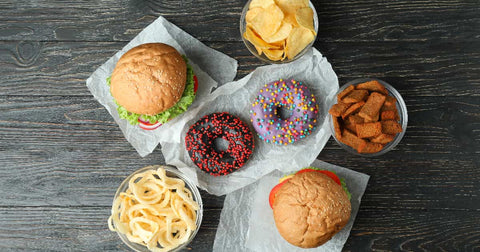Cravings for those indulgent treats hit us all! But understanding which ones pack the biggest caloric punch is key for making informed decisions about how often to enjoy them. Let's uncover some of the worst offenders when it comes to calorie overload.
1. Sugary Drinks

Not Just Soda:
- Sports Drinks: Unless you're a serious athlete, you don't need the sugar rush. A 20oz bottle can have 150+ calories.
- Sweetened Iced Tea: Bottled versions are basically liquid candy. Even "natural" ones often have upwards of 30 grams of sugar per serving. A 12oz can or bottle contains 120-180 calories.
- Flavored Waters: Many have added sugar, clocking in at 100+ calories per bottle, not much better than soda.
- Coffee Confections: Caramel lattes, frappuccinos... a large can top 500 calories and contain as much sugar as several ice cream cones!
Sneaky Sugar:
- Fruit Juices: While containing some vitamins, they lack fiber, causing blood sugar spikes. An 8oz glass of apple juice has about 120 calories.
- Smoothies: Can be healthy, but store-bought ones are often loaded with added sugar or syrups, pushing them into dessert territory. Calories can vary anywhere from 200-800+.
Ditch the Sugar High:
- Water Power: Make it interesting with sliced fruit, mint, or a splash of unsweetened juice.
- Plain, But Not Boring: Unsweetened iced tea or black coffee offer flavor and a caffeine boost, calorie-free.
- DIY Control: Make your own smoothies with unsweetened base (yogurt, plant milk), focusing on whole fruit for sweetness.
Important Note: "Zero sugar" versions using artificial sweeteners come with their own debate about health impacts. Water is always the safest, most natural bet!
2. Fried Foods

- Double the Fat, Double the Trouble: Frying not only adds fat from the oil itself, but the food soaks up a significant amount. This massively ups calorie content.
- Oil Matters: Unhealthy saturated and trans fats used in some fast-food spots make it even worse for your health beyond just calories.
Common Culprits:
- French Fries: A medium order of fast-food fries packs around 350-400 calories, mostly from fat.
- Fried Chicken: A 3-piece chicken meal (breast, thigh, wing) can easily top 800 calories.
- Fish and Chips: This classic combo clocks in at around 500-700 calories, depending on portion size.
- Doughnuts: A single glazed donut has about 250 calories, a chocolate frosted one, closer to 350.
- Fried appetizers: Mozzarella sticks, onion rings...add another few hundred calories to your meal before it even starts.
The Healthier Flipside:
- Baked: Using a bit of healthy oil and your oven gives food a crispy texture without the calorie overload. Think baked sweet potato fries or oven-fried chicken.
- Grilled: Adds flavor while using minimal fat - great for burgers, chicken, fish, etc.
- Air-Fryer: A small amount of oil goes a long way, achieving a crispness similar to frying with a fraction of the calories.
Important Note: Even 'healthier' fried alternatives are best enjoyed in moderation. Portion control is still key alongside focusing on whole, unprocessed foods most of the time.
3. Pizza

Pizza: When Toppings Become Calorie Bombs
- The Base Matters: While not super high-calorie on its own, thick crust or stuffed crust varieties add up. A thin crust is always a better starting point.
- Cheese Overload: Extra cheese is tempting, but significantly boosts both calories and saturated fat. A moderate sprinkle is plenty.
- Processed Meats: Pepperoni, sausage, etc., are packed with fat and sodium. Opt for grilled chicken, shrimp, or load up on veggies instead.
- Oily Extras: Drizzles of sauces packed with oil add unnecessary calories. Ask for light sauce or a sprinkle of herbs for flavor.
Portion Distortion:
- Restaurant Slices: Those giant slices? Often the equivalent of 2-3 standard portions, easily nearing 500-700 calories per slice.
- Personal Pan Pizzas: While smaller, can still pack 500+ calories depending on toppings.
Pizza Can Be Healthier:
- Build Your Own: Start with a thin whole-wheat crust if available, light sauce, part-skim mozzarella, and pile on fresh veggies.
- Side Swap: Skip the breadsticks or fries and pair your slice with a big salad.
- Smaller Portions: Share a pizza, savor a couple of slices, or save leftovers instead of eating the whole pie in one sitting.
Pizza Realities: Even with smart choices, it's not a low-calorie food. Think of it as a delicious treat to be enjoyed occasionally, not a dietary staple.
4. Creamy Sauces & Dressings

Creamy Sauces & Dressings: The Calorie Trap
- Fat = Calories: The creamy texture comes from heavy cream, butter, oils, or full-fat dairy – all of which are calorie-dense.
- Sneaky Serving Sizes: It's easy to pour on way more than a standard serving, especially with restaurant dressings.
The Numbers: Calorie Shock
- Alfredo Sauce: A mere 1/4 cup serving packs around 150 calories, mostly from fat!
- Ranch Dressing: Just 2 tablespoons of store-bought ranch has about 130 calories.
- Restaurant Caesar Salad: The dressing alone can top 300 calories and a hefty dose of saturated fat.
Healthier Swaps: Big Flavor, Fewer Calories
- Vinaigrettes: Oil-based, but use far less, with tangy vinegar for flavor. A basic balsamic clocks in around 50 calories per 2 tbsp serving.
- Salsa: Chunky, fresh, and bursting with veggie goodness, it's naturally low-calorie. Watch out for sugary or heavily salted store-bought ones.
- Yogurt-Based: Plain Greek yogurt, herbs, and a bit of lemon juice create a creamy base. Add mustard for a tangy Dijon-style dressing.
- DIY Dressings: You control the ingredients and portions! Search online for lightened-up versions of your favorites.
Important Note: Even "healthy" dressings can add up if you use a heavy hand. Moderation is still key!
5. Processed Meats

Processed Meats: More Than Just Calories
- Hidden Fat: Even seemingly "lean" options are often surprisingly high in saturated fat, the kind that negatively impacts your heart health.
- Sodium Overload: Processed meats are heavily salted for preservation, contributing to high blood pressure and other health risks.
- Preservatives & Additives: Nitrates, linked to potential cancer risks, are found in many processed meats.
- Calorie Check: While calorie counts vary widely, some examples:
- 2 slices of bacon: ~90 calories
- 1 hot dog: ~150 calories
- 3 oz deli ham: ~120 calories
The Bigger Health Picture:
Beyond just calories, studies increasingly link frequent consumption of processed meats with:
- Increased Heart Disease Risk: They clog your arteries and raise cholesterol.
- Colorectal Cancer: Evidence points to an increased risk with regular intake.
- Type 2 Diabetes: Processed meats can contribute to insulin resistance.
- Other Concerns: Impacts on weight gain, inflammation, and overall health are ongoing areas of research.
Smarter Protein Choices:
- Lean & Unprocessed: Focus on whole cuts of chicken, turkey breast, or fish.
- Grill or Bake: Cooking methods that avoid adding extra fat are best.
- Plant-Based Power: Beans, lentils, tofu, and tempeh are excellent, healthy protein options.
- Treat it Like a Treat: If you enjoy processed meats, do so rarely, in small amounts, as part of an overall balanced diet.
6. Sugary Baked Goods

Sugary Baked Goods: Calories in Sweet Clothing
- Sugar + Refined Carbs: This combo causes blood sugar spikes and crashes, leaving you hungry again soon after, while contributing to weight issues.
- Sneaky Fat: Muffins, cookies, etc., pack in butter, oil, shortening... calories add up fast alongside the sugar overload.
- Empty Calories: These offer minimal nutritional value – vitamins, fiber, and healthy fats are missing from the picture.
The Calorie Reality:
- Giant Muffins: Bakery-style muffins are often the equivalent of several slices of bread, easily hitting 500-600+ calories.
- Donut Deception: A single glazed donut has about 250 calories, chocolate frosted ones closer to 350.
- Cookie Crumble: Seems small, but 2-3 average cookies can tally 200+ calories.
- Cake Catastrophe: Even a modest slice of birthday cake can contain upwards of 400 calories.
Healthier Indulgences:
- Smart Swaps: Fruit satisfies a sweet tooth naturally. Think baked apples, poached pears, or a fruit salad with a dollop of light whipped cream.
- Mini Treats: Enjoy one small, high-quality cookie to savor the flavor, not a whole sleeve.
- DIY Baking: Use whole-wheat flour, cut back sugar, add fruit for sweetness – online recipes for healthier cookies or muffins abound.
- Portion Perspective: Split a large muffin, share a dessert – moderation is key!
Important Point: "Healthy" halos around store-bought muffins with bran or fruit are misleading. They're still loaded with sugar and refined carbs.
7. Ice Cream

Ice Cream: The Calorie Trap
- Sugar & Fat Combo: The creamy texture comes from a mix of milkfat and lots of added sugar. Even "light" versions rely on sweeteners that keep the calories higher than you'd think.
- Portion Distortion: A single scoop seems small, but few people stop there. Those tempting pints make it easy to overeat.
- Toppings Take a Toll: Hot fudge, whipped cream, candies, etc., add a hefty additional calorie load.
Calorie Check:
- "Light" Ice Cream: A 1/2 cup serving can still have 100+ calories.
- Premium Ice Cream: A 1/2 cup serving often packs 150-200 calories.
- Mix-Ins: Each spoonful of candy bits, cookie crumbles, etc., adds another calorie surge.
- Sundaes: Easily surpass 500+ calories depending on toppings.
Healthier Alternatives:
- Portion Control: Stick to a single small scoop and savor it slowly.
- Sorbet & Frozen Yogurt: Offer fruity flavor, usually with fewer calories. Watch out for added sugar in store-bought versions, though.
- DIY Ice Cream: Use frozen bananas, natural sweeteners, and your blender for healthier variations.
- Focus on Toppings: Fresh berries or a sprinkle of nuts are better than sugary sauces.
Important Note: Occasional ice cream treats are fine! But consider them a splurge, not an everyday food, and be mindful of how toppings quickly double or triple your calorie intake.
What Food Makes You Gain Weight the Fastest?
It's not a single food, but a pattern: Consistently consuming more calories than you burn. These high-calorie, low-nutrient foods make it easy to overdo it.
Beyond Calories: Food Intolerances & Gut Health

Sometimes, even with sensible eating, weight gain or digestive woes linger. Hidden food intolerances can contribute to inflammation, bloating, and a sluggish metabolism.
Our easy, at-home test kit helps identify potential food sensitivities hindering your health goals. Personalized results empower you to optimize your diet for lasting well-being.
Frequently Asked Questions:
1. Are there any truly healthy types of junk food?
Unfortunately, no. While some options are slightly better (baked vs. fried), these foods are still best as occasional treats, not dietary staples.
2. Which is worse for weight gain: sugary drinks or fried foods?
Both contribute significantly! Sugary drinks are sneaky, though, as you don't feel as full. It's a matter of finding your personal pitfalls.
3. I only eat processed meats occasionally, is that okay?
It's better than eating them frequently, but even occasional intake carries some increased health risks. Focus on whole, unprocessed protein sources most of the time.
4. What about "diet" versions of ice cream and baked goods?
They can be slightly lower in calories, but often rely on artificial sweeteners and still lack nutritional value. Small portions of the real deal might be more satisfying.
5. If I work out a lot, can I eat more of these unhealthy foods?
Exercise is vital, but it doesn't negate a poor diet. You might avoid weight gain, but these foods still negatively impact your overall health.


.png?v=1737390083)
.png?v=1737187409)


